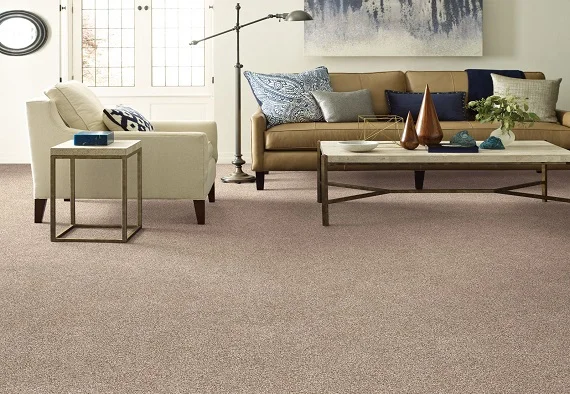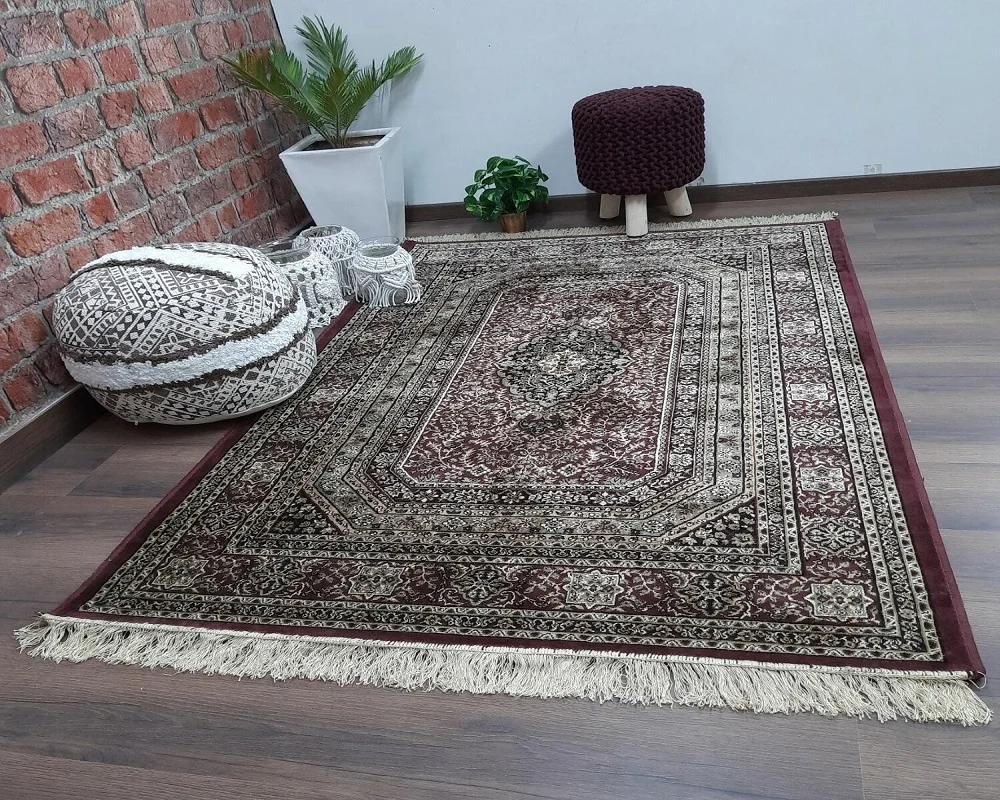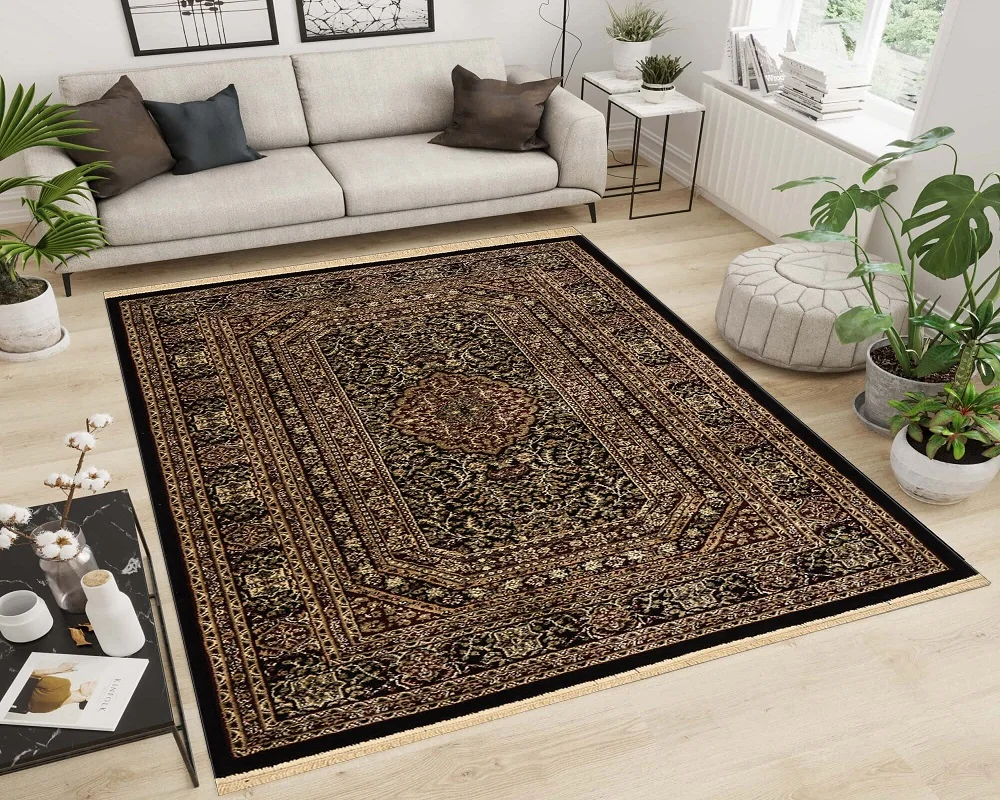The Timeless Artistry of Persian Carpets
Persian carpets, also known as Iranian carpets, are the epitome of artistic and cultural expression that has captivated the world for centuries. These handwoven masterpieces are renowned for their intricate designs, vibrant colors, and exceptional craftsmanship. Rooted in the rich history of Persia (modern-day Iran), the tradition of carpet making in this region dates back over 2,500 years, making it one of the oldest and most revered art forms in the world. What makes Persian carpets truly exceptional is the blend of history, culture, and artistry woven into each thread. They come in a wide array of styles, ranging from the geometric and bold Heriz carpets to the delicate floral patterns of Isfahan. Persian carpets are more than just floor coverings; they are repositories of Persian culture, with designs that often incorporate elements like Persian gardens, mythical creatures, and historic symbols. These carpets are not just aesthetic marvels but also significant investments. They are known for their durability and can last for generations when well-maintained. Whether you’re an art connoisseur, a history enthusiast, or simply someone looking to add a touch of elegance to your home, Persian carpets offer a fascinating journey into the heart of Persian culture and craftsmanship.

GET UPTO 30% DISCOUNT
CLEARANCE SALE | LIMITED TIME OFFER | HURRY UP! Book A Free Appointment
Exploring the Rich Tapestry of Popular Persian Carpet Types

The world of Persian carpets is a tapestry of culture, history, and artistry, and within this realm, a diverse array of carpet types weaves an intricate story. Persian rugs are celebrated for their exceptional quality, craftsmanship, and unique regional styles. Here, we embark on a journey through some of the most renowned and beloved Persian carpet types.
- Tabriz Carpets: Hailing from the city of Tabriz, these carpets are characterized by their elaborate floral and pictorial designs. They often feature intricate medallion patterns and a harmonious color palette.
- Isfahan Carpets: Isfahan carpets are celebrated for their symmetrical designs and intricate, delicate motifs. They are known for their exceptional craftsmanship and artistic detail.
- Kashan Carpets: These carpets from Kashan are famous for their curvilinear designs and a central medallion. They often feature bold, vibrant colors and fine knotting.
- Heriz Carpets: Heriz carpets, produced in the Heris region, are distinct with their bold geometric patterns and a color palette dominated by warm, earthy tones. They are known for their durability.
- Qom Carpets: Qom carpets are prized for their fine silk threads, intricate floral motifs, and a soft color scheme. They are often considered among the most luxurious Persian carpets.
Unraveling the Rich Tapestry of Cultural and Symbolic Meanings in Persian Carpets
In the world of Persian carpets, every intricate design is not merely a feast for the eyes but also a profound tapestry of cultural and symbolic significance. These handwoven masterpieces tell stories that transcend time, culture, and borders, making them more than just flooring but cherished works of art.
At the heart of these intricate patterns are symbols that have been passed down through generations. The symbolism in Persian carpets is a reflection of the deep cultural roots of Iran. The recurring motifs in these carpets, such as the Tree of Life, the Garden of Paradise, and the Herati pattern, hold unique meanings. For example, the Tree of Life represents the cycle of creation and the eternal bond between heaven and earth. The Garden of Paradise, on the other hand, is a symbol of earthly and spiritual joy.
Colors in Persian carpets are also laden with meaning. Red symbolizes love and passion, blue represents the infinite, and green signifies nature and life. These symbols and colors vary across different regions and styles, providing an intriguing glimpse into the diversity of Persian culture.
Whether you are an art enthusiast or a carpet collector, delving into the cultural and symbolic meanings of Persian carpet designs adds a deeper layer of appreciation for these timeless creations, where every thread tells a story and every knot weaves a connection to Iran’s rich heritage.

Why Choose Us?
- Unwavering Commitment to Authenticity: We take pride in offering only authentic Persian carpets. Our collection is a testament to the craftsmanship and artistry passed down through generations.
- Exquisite Selection: Our inventory boasts a diverse range of Persian carpet styles, from classic to contemporary, catering to various tastes and interior designs. Discover carpets from renowned regions like Tabriz, Isfahan, and Kashan.
- Quality and Craftsmanship: Every Persian carpet in our collection is a masterpiece, crafted with the finest materials and traditional techniques by skilled artisans. We stand by the quality of our products.
- Expert Guidance: Our team is comprised of experts with an in-depth knowledge of Persian carpets. We provide guidance and information to help you make an informed choice based on your preferences and needs.
- Ethical Sourcing: We are committed to ethical sourcing and fair trade practices. When you choose our carpets, you support both the preservation of this art form and the well-being of the artisans.
- Competitive Pricing: We offer competitive prices without compromising on quality. Your investment in a Persian carpet from us is not only a testament to your style but also a smart financial decision.
- Customer Satisfaction:We go the extra mile to ensure that your experience with us is seamless, from the moment you browse our selection to the delivery of your chosen carpet.
FAQs
- A1: Persian carpets are typically made of natural materials, including high-quality wool, silk, and occasionally, cotton. These materials contribute to the carpets' durability and luxurious texture.
- A2: Yes, Persian carpets are known for their durability and can withstand moderate to high foot traffic. However, it's advisable to use rug pads to protect them and rotate the carpet occasionally to distribute wear evenly.
- A3: Regular maintenance involves vacuuming your carpet with a low-suction setting to remove dirt and debris. To prevent staining, clean spills immediately with a blotting technique. Professional cleaning is recommended every 1-2 years to maintain the carpet's quality.
- A4: The motifs in Persian carpets are often symbolic and hold cultural meanings. For example, the Tree of Life symbolizes the cycle of creation, and the Herati pattern represents fish or the eternal soul. The specific meanings can vary by region and design.
- A5: Traditionally, Persian carpets are meticulously handwoven by skilled artisans. While there are machine-made versions available, the most highly valued and sought-after Persian carpets are handwoven.
- A6: Look for the "Persian knot" on the back of the carpet, as well as the quality of materials and the intricacy of the design. Additionally, purchasing from reputable dealers and obtaining a certificate of authenticity can help ensure the carpet's genuineness.
- A7: Each region in Iran has its unique carpet style with distinctive patterns, color palettes, and weaving techniques. For instance, Tabriz carpets are known for their floral designs, while Kashan carpets often feature intricate medallions.
AREAS WE SERVE
Dubai Areas
Emirates Hills, Jumeirah Golf Estate, Dubai Marina, Palm Jumeirah, Jumeirah Umm Suqeim, Trade Centre area, Downtown, Al Safa, Mirdif, Arabian Ranches, Jumeirah Lakes Towers, Jumeirah Beach Residence, Business Bay, Al Barsha, Dubai Sports City, Al Garhoud Lakes, Springs Meadows, Motor City, Jumeirah Village, The Greens, The Gardens, The Green Community, Jumeirah Village circle, Jumeirah Village triangle, Dubai investment Park, Jumeirah Park, Al Furjan,
Dubai Hills & Mohammed bin Rashid City
Abu Dhabi Areas
Yas Island, The Corniche Area, Saadiyat Island, Al Reem Island, Al Maryah Island, Tourist Club Area, Khalifa City, Al Khalidiyah, Al Reem Island, Khalifa City, Mohammed Bin Zayed City, Al Reef, Al Raha, Al Mushrif Al Karamah
Emirates
Dubai, Abu Dhabi, Sharjah, Umm al-Qaiwain, Fujairah, Ajman and Ra’s al-Khaimah


